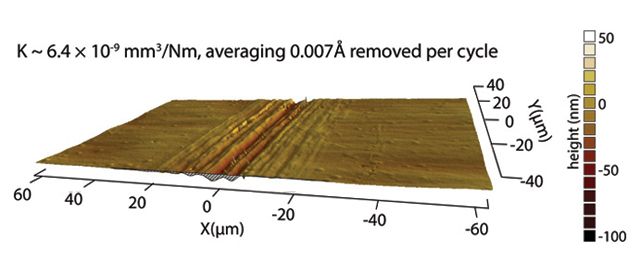Latest findings could reveal future implementation in smartphones, space vehicles and more.
Gallium nitride (GaN) has emerged as one of the most important and widely used semiconducting materials. Its optoelectronic and mechanical properties make it ideal for a variety of applications, including light-emitting diodes (LEDs), high-temperature transistors, sensors and biocompatible electronic implants in humans.
In 2014, three Japanese scientists won the Nobel Prize in physics for discovering GaN’s critical role in generating blue LED light, which is required, in combination with red and green light, to produce white LED light sources.
Now, four Lehigh engineers have reported a previously unknown property for GaN: Its wear resistance approaches that of diamonds and promises to open up applications in touch screens, space vehicles and radio-frequency microelectromechanical systems (RF MEMS), all of which require high-speed, high-vibration technology.
The researchers reported their findings in August in Applied Physics Letters (APL) in an article titled “Ultralow wear of gallium nitride.” The article’s authors are Guosong Zeng, a Ph.D. candidate in mechanical engineering; Nelson Tansu, the Daniel E. ’39 and Patricia M. Smith Endowed Chair Professor in the electrical and computer engineering department and director of the Center for Photonics and Nanoelectronics (CPN); Brandon A. Krick, assistant professor of mechanical engineering and mechanics; and Chee-Keong Tan ’16 Ph.D., now assistant professor of electrical and computer engineering at Clarkson University.
GaN’s electronic and optical properties have been studied extensively for several decades, said Zeng, the lead author of the APL article, but virtually no studies have been done of its tribological properties, that is, its resistance to the mechanical wear imposed by reciprocated sliding.
“Our group is the first to investigate the wear performance of GaN,” said Zeng. “We have found that its wear rate approaches that of diamonds, the hardest material known.”
The Lehigh researchers measured the wear rate and friction coefficients of GaN using a custom microtribometer to perform dry sliding wear experiments. They were surprised by the results.
Tansu, who has studied GaN for more than a decade, and Krick, a tribology expert, became curious about GaN’s wear performance several years ago when they discussed their research projects after a Lehigh faculty meeting.
“Nelson asked me if anyone had ever investigated the friction and wear properties of gallium nitride,” said Krick, “and I said I didn’t know. We checked later and found a wide-open field.”
Tansu said the group’s discovery of GaN’s hardness and wear performance could have a dramatic effect on the electronic and digital device industries. In a device such as a smartphone, he said, the electronic components are housed underneath a protective coating of glass or sapphire. This poses potential compatibility problems, which could be avoided by using GaN.
Read the full story at the Lehigh University News Center.
-Kurt Pfitzer is Manager of Editorial Services with Lehigh University's Office of Communications and Public Affairs.



